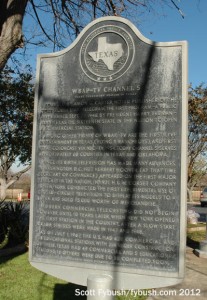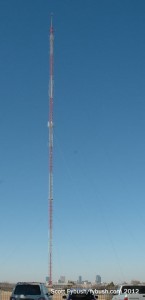NorthEast Radio Watch 12/15/2025: NYC Morning Shakeup
In this week’s issue… NYC morning shows exit - Carton back amidst WFAN shakeup - FM signing off in Canada - More radio centennials
Text and photos by SCOTT FYBUSH
This week’s installment is a special one for us, because it completes (at long last) our “Things That Won’t Be There Much Longer” tour that stretched over much of 2012. Over the course of that year, we at first failed (and then finally succeeded) at getting out to Catalina Island off the California coast to see KBRT before it moved inland. We made it to St. Louis to see the historic KMOX studios before they moved away from the Gateway Arch.


And on a mild December morning, we made it to Broadcast Hill east of Fort Worth, Texas to see the studios of NBC’s KXAS (Channel 5) and KFWD (Channel 52) in the last few months before they uprooted from here and relocated to new digs closer to Dallas.
It’s a very, very good thing that the founder of channel 5 had already been dead for three decades, because if Amon Carter, Jr. were still alive and found out his station was moving to that rival city 30 miles to the east, he’d probably have been trying to close down I-30 to keep the move from happening.
Carter’s father, Amon Sr., started the family in the broadcasting business, founding WBAP radio as an adjunct to his Star-Telegram newspaper. Even though he ended up cooperating closely with Dallas rivals – WBAP, after all, ended up sharing the clear channel on 820 with the Dallas Morning News‘ WFAA, and then adding a second frequency at 570 as a mirror-image of the share-time – he also famously packed a lunch bag when he had to go to Dallas, just so he wouldn’t have to spend his money in a Dallas establishment.
You get the picture: the Carters were the biggest boosters of Fort Worth and Tarrant County that ever lived, so the impending move of their old TV station closer to Dallas was one big reason we wanted to get here while it was still on the Fort Worth side.
Another reason, as these photos should start to indicate, is that we have a passionate interest in the first buildings built specifically for television at the dawn of the medium, and this building goes right back to channel 5’s launch on September 29, 1948, as WBAP-TV.
The start of WBAP-TV was part of a flurry of new TV operations in what wasn’t yet the merged “Dallas-Fort Worth” market. On the Dallas side, KRLD-TV (Channel 4) and KBTV (Channel 8) both signed on in 1949, and just a short time later KBTV was sold to WFAA to become WFAA-TV.
But channel 5 came first, and it did so right here on the east side of Fort Worth, at 3900 Barnett Street, a property Carter dubbed “Broadcast Hill.” The new building claimed to be the first in the country specifically designed as a television studio, though the history is a little murky on that point: in Milwaukee, WTMJ-TV (Channel 3, later 4) had already signed on in 1947 from Milwaukee Radio City, a facility built for TV way back in 1941. Be that as it may – there aren’t very many TV facilities this old in the country, and it’s a treat to get to see any of them, even one that’s been as heavily renovated over the years as this one.
So shall we start our tour? Once past the gate and into the parking lot, the KXAS building looks vaguely like an elementary school – lots of brick, a squat, two-story layout and a little bit of tiled roofing to give a Mission flavor to it all. Inside, once past the lobby, a low-ceilinged hallway runs the length of the building from the rack room on the north end to the newsroom on the south side.
We start our tour on the north end of things, in a space that once housed master control for WBAP-TV and WBAP radio, as well as the transmitter for WBAP-TV. (The transmitters for WBAP radio were shared with WFAA, on a piece of land 20 miles or so northeast of here that’s now paved over by DFW airport runways.)
Today, the master control for KXAS is hundreds of miles away in Atlanta, where all of NBC’s owned-and-operated stations contract out their master control operations. The former master control space next to the rack room is now a transmission control area, and when we visit they’re tuning in various live shots for the midday news. Down the hall, the noon news is being produced in a fairly recently renovated control room adjoining the big studio where the KXAS newscasts originate.
This set and studio look commonplace enough, until you start to notice a few subtle reminders that this studio was built before anyone really knew what a TV studio was supposed to look like.
Look very, very closely at the wall up above the weather desk and you’ll see something you don’t see very often these days: there’s a window up there, looking into the studio from what’s now a conference room but was once a sponsor viewing area to peer down through the lighting grid at the live shows that once came out of here.
Next door to the main KXAS studio is a smaller studio that was once the main WBAP radio studio complex. Today it’s used for the other TV station that operates from here. KXTX (Channel 39) is the Telemundo station in town, now an NBC-owned sister station to KXAS. This control room is rather older than KXAS’; indeed, KXTX’s news was still in SD until both stations moved to their new home in 2013.
The clue that this was once a radio studio can be found right when we walk into the relatively small space: that door sits in a jamb that’s nearly a foot thick, and check out the 1940s-style sound treatment there on the walls!
On the south end of the building, the original space has been renovated many times over to make room for an expanding news operation. The combined KXAS/KXTX newsroom (which also serves as the Dallas/Fort Worth bureau for NBC News) not only takes up most of this end of the building, it even includes an atrium area cut into the second floor above, which is otherwise occupied by sales space and some regional Telemundo offices.
A few other touches from 1948 still remain: that’s an original on-air light that we pass as we walk down the hall to check out some of the behind-the-scenes parts of this big building. Behind the TV studios is a big open area that’s now used for storage, but was once where scenery was moved in and out, not to mention cars for live commercials.
We step outside at this point to look at some of what’s been added to the back of the building: there’s a national graphics center for NBC’s local stations that has a facility of its own tucked way in the back here, past the garages where some of the station vehicles are stored.
It’s out here, too, that we get to see the tower that carried WBAP-TV’s signal for its first 16 years. Even after building a taller stick here, channel 5 still lacked the reach into the Dallas side of the market that its rivals had, and by the early 1960s NBC was increasingly unhappy about its signal deficiency in the market. In 1964, NBC finally persuaded Carter to move channel 5 to the Cedar Hill tower farm south of town, and ever since then the tower here has been used only for STL and ENG purposes.
By then, of course, the Dallas area had become nationally famous for something else, too, and WBAP-TV played a big role in the nation’s experience of the Kennedy assassination. If you’ve ever seen the NBC minute-by-minute coverage that gets replayed on many anniversaries, you know that much of the initial reporting the nation saw came from right here at channel 5, and in color, no less, at a time when the network itself was still producing news only in black and white.
Which brings us back inside the building and down to the basement, a treasure trove of history from both the radio and TV sides of the building. It’s been four decades since the radio and TV stations were sold to separate owners, but even after WBAP radio moved out in 1974, some of its history remained behind, including these logbooks from the 1940s. When we stopped by in 2012, efforts were underway to preserve much of the channel 5 history that still lived down here, including boxes upon boxes of vintage news film and tape. (The Kennedy material, I’m told, had largely already gone to the Sixth Floor Museum over in Dallas.)
By the time we visited here, construction was already underway on the new home of KXAS and KXTX, at a location with its own Amon Carter history. What’s now the CentrePort business park, just south of DFW airport, was itself an airport in its own right, the magnificent and mostly forgotten Art Deco Greater Southwest Airport, aka Amon Carter Field, which explains why the station’s new address is on Amon Carter Boulevard, the former airport’s Runway 17/35.
KXAS and KXTX made their move to a new facility there in October 2013, and earlier this year NBC donated the Broadcast Hill building and land to the city of Fort Worth, which has not yet determined what it will do with the site.

As we announced a few weeks ago, the 2026 edition of the Tower Site Calendar will be the last.
We began publishing it 25 years ago, and the broadcast landscape is radically different now.
Radio World just ran an excellent article about us if you want to know more.
Once it’s gone, that’s it. We won’t be printing any more.
Thank you to everyone who saw our announcement and rushed to buy it. We appreciate you.
(There are some calendars from previous years if you want more of a tower photo fix — all under $5.)
But don’t wait to get this year’s Tower Site Calendar — buy it now!
We are selling the Broadcast Historian’s Calendar again this year, but we have that in an even smaller quantity — definitely don’t hesitate for that.
And visit the Fybush Media Store to check out our selection of books and videos, too!
Next week: Dallas 2012 – Radio Studios, and Some TV, Too
In this week’s issue… NYC morning shows exit - Carton back amidst WFAN shakeup - FM signing off in Canada - More radio centennials
In this week’s issue… Veteran newsman returns - Remembering NY's Leitner, RI's Jones - CT AM saved - Maine AM moves - "Indie" adds suburban signals
In this week’s issue… Scripps stations face takeover - Sinclair moves more affiliations - CT stations sold - Maine AM surrendered - Remembering WVBR's Shapiro, WABC's Morgan
In this week’s issue… CT TV legend succumbs to cancer - Remembering PA's Adams - FCC still stalled by shutdown - Pittsburgh morning host exits